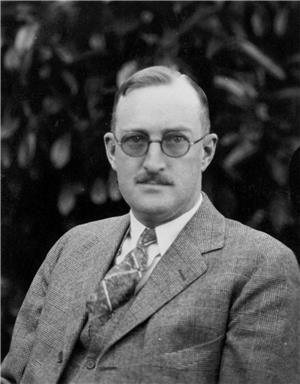In 1925, when the timberland holdings of the Puget Mill Company were sold to an eastern lumber company, the Blue Ridge community in Seattle's northwest corner became a possibility. William E. Boeing (1881-1956), lumberman, mining entrepreneur, and airplane builder, bought up most of the company's land overlooking Puget Sound north of the city limits to Richmond Beach. Soon the Douglas fir and cedar stands would be sacrificed for the development of the exclusive communities of Innis Arden and Blue Ridge. Today (2001), 450 homes sit on a 200-acre cul-de-sac that abuts Carkeek Park, whose western facing slopes offer spectacular views of the Puget Sound area. This acreage, bounded on the east by 12th Avenue NW and on the south by NW 100th and NW 105th streets, constitutes the upscale, covenanted community of Blue Ridge.
From Trees to Seaplanes
Trees, not airplanes, brought Bill Boeing to the Pacific Northwest. The product of a wealthy Detroit timber and mining family, he followed family holdings to Aberdeen in 1902, where he spent five years learning the lumber business and became president of Greenwood Logging Company. He arrived in Seattle in 1908. Within eight years, he was testing seaplanes for the government on the watery tarmac of Lake Union. Military and U.S. airmail contracts were the hallmarks of Boeing's success.
But by 1934, Boeing had received a bruising from antitrust legislation forbidding the same company from building airplanes and carrying the mail. Additionally, his firm had gotten caught up in a scandal involving the postmaster general's distribution of profitable mail routes among fledgling airlines, including Boeing's United Air Lines. William Boeing retired at the age of 50. He now involved himself in new and ongoing business pursuits. One of these was land development.
Boeing's Blue Ridge
The Blue Ridge project got off the ground in 1927. By 1932, the acreage was logged off, platted, and the real estate office at the new community's southern edge open for business. The first residences to go up were five large brick homes built for Boeing executives along Blue Ridge Drive, which offered the most expansive views in the area. Still standing today, these originals are affectionately known by community residents as "the castles."
The Great Depression of the 1930s held development of the new community to a slow pace. But World War II brought prosperity to the region and attention to the former Puget Mill Company timberland. By 1950, more than half the lots were now occupied by the upper middle class, and a decade later virtually all of the niches between the homes of the elite had been filled in.
From the outset, the Blue Ridge hillside community was planned as an exclusive "residential park," with covenant-restricted access to a community club, a swimming pool, tennis courts, playfields, and a private beach. Until outlawed by the Supreme Court in 1948, a racial exclusion clause successfully kept minorities out:
"No person other than one of the White or Caucasian race shall be permitted to occupy any property ... except a domestic servant actually employed by a person of the White or Caucasian race where the latter is an occupant of such property."
Today, with home ownership at 100 percent, the all-residential Blue Ridge neighborhood, still an overwhelmingly upper-middle-class white community, is situated in a pristine, out-of-the-way corner of a busy, noisy, and metropolitan Seattle, where it offers both a sense of place and coveted privacy.

